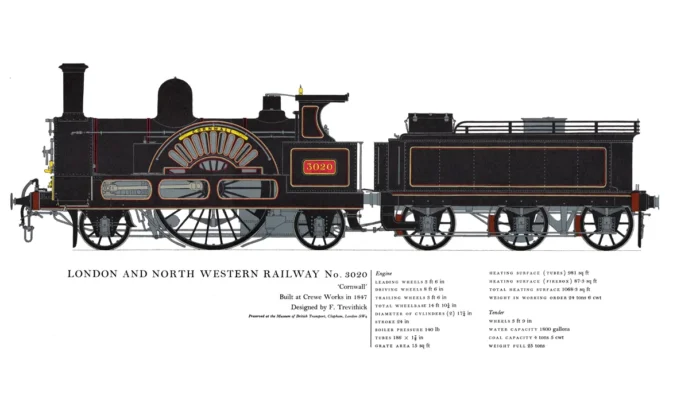London & North Western Railway, 1847
£15.00
LNWR 2-2-2 No. 3020 ‘Cornwall’ was built at Crewe in 1847 as a 4-2-2 but rebuilt and converted to 2-2-2 in 1858 (scroll down for a more detailed Description)
Published 1967 by Hugh Evelyn Limited; drawn by © Ernest W. Fenton
Size: c. 43.5 x 25.5 cm (17 ″ x 10 ″] may vary slightly from printers’ cut 50 years ago
Printed on white medium cardstock weighing c. 135 g/sm2
Print is LARGE size – shipping is the same for 1 to 10 prints (based on largest print size in your order) – see Shipping & Returns
In stock
Description
LNWR 2-2-2 No. 3020 ‘Cornwall’ is a preserved steam locomotive built at Crewe in 1847. Originally a 4-2-2 but rebuilt and converted to 2-2-2 in 1858. In the 1840s locomotive design focussed on the need for single large-diameter driving wheels of around 8 ft (2.4 m). Later, increasing engine power would require better adhesion than a single pair of driving wheels could provide, but that was not a problem at the time. Stability also required a low centre of gravity, and thus a low-slung boiler. The two conditions were in conflict, because the boiler would take up the space needed for the driving axle. One solution was the Crampton design, in which the driving axle was moved behind the boiler’s firebox. Cramptons were most popular in France and Germany, but some were also used in England. Francis Trevithick had a notable pedigree as a locomotive engineer, being the son of Richard. He had moved North to become resident engineer, then Locomotive Superintendent of the Grand Junction Railway (GJR) (later formed into the LNWR). Cornwall was named after the county of his birth. The locomotive is now part of the National Railway Museum and is normally on display in York or Shildon.
Additional information
| Weight | 0.0169 kg |
|---|---|
| Dimensions | 43 × 25 cm |





